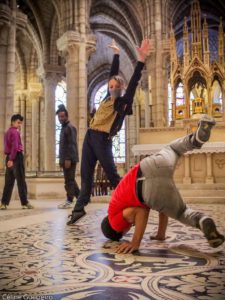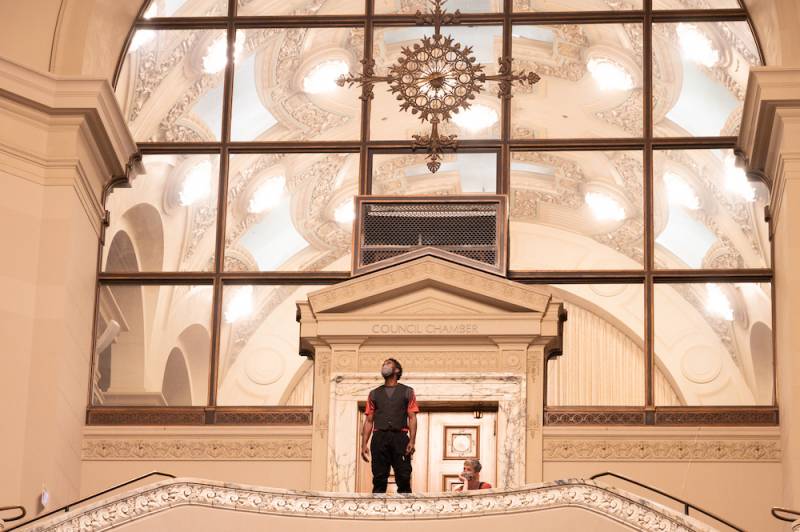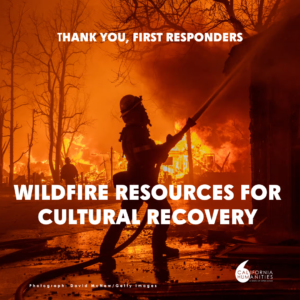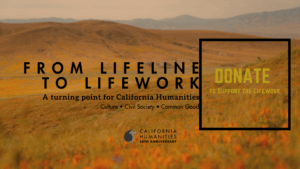As part of the Oakland/Saint-Denis Cooperation Project, Kaimera Productions created and delivered SPACES: Oakland in July 2021, with support from a Humanities for All Project Grant. These integrated dance and storytelling performances at Oakland City Hall in July 2021 and in the French city of Saint-Denis, a suburb (or banlieue) of Paris in late September 2021, bring community members together with professional dancers to tell local stories. In this interview, Kaimera’s Artistic Director, Simón Adinia Hanukai, based in Paris, tells us more about this unique project.
Where did the idea for the SPACES project come from in general, and why did you decide to do a dual performance in Oakland and Saint-Denis, France?
The first iteration of Kaimera’s SPACES project was commissioned by the 2017 Harlem Arts Festival in New York City. The festival producers were familiar with our work and were particularly interested in the way we engage the local community and the spaces that our projects occupy.
When we received the commission, we never imagined that we would be creating the piece in the aftermath of the 2016 presidential election in the US and at the height of the refugee crisis plaguing the Middle East, North Africa, and Europe. It became apparent that we were entering a new era of division, putting into question our sense of belonging and our sense of community.
As we started the creative process, we were looking first and foremost to help unify, strengthen bonds within existing communities, and create new ones between people where they might not have existed. This felt like the perfect time for the simplest of artistic formats: storytelling.
I challenge anyone to truly listen to a stranger’s personal story and still want to alienate them. To be transported into a moment in their journey and then tell them that they don’t belong. To witness a stranger offering them a little part of themselves and not feel a moment of connection. To glimpse into what makes that individual tick and not fall in love with them, even if just a little bit.
SPACES, which has since developed into a larger multi-platform international artistic initiative, is our little antidote to the division our society has been experiencing and a catalyst for healing and connection, locally and globally.
About a year after this initial SPACES iteration, we were approached by Juliette Donadieu, who was at the time the cultural attaché at the French Consulate of San Francisco. Juliette was in the initial stages of creating the Oakland/Saint-Denis cooperation project and felt that SPACES could serve as a powerful tool to connect the two communities through art and storytelling in public spaces of great importance to the two cities: Market Hall and Basilica of Saint-Denis and the City Hall of Oakland. The rest is history.

Why is the international approach such an important component of SPACES?
The primary focus of SPACES is actually hyper-local. It’s about reclaiming space to share stories about a place that we call home with friends and strangers, with whom we inhabit it. It’s a reminder of how interconnected and interdependent we all are while showcasing the beauty that our diverse backgrounds and perspectives bring to our shared experience.
The international approach was a discovery. As we began the dialogue about bringing SPACES to different cities, whether it’s Oakland (USA), Saint-Denis (France), Delhi (India), or the Island of Mozambique (Mozambique), conversations with local partners brought to light the similarities of experiences, whether it’s stories of falling in love or the impact of gun violence, overcoming a challenge or displacement due to gentrification. We realized that the piece can serve to unify a local community while simultaneously building links to others on the other side of the globe. As a company whose team comes from multiple countries and continents, working in this manner has been exciting and natural all at once.
Tell us more about your goals with the project (such as the specific public spaces you’ve chosen in both places and the local storytelling component).
Each iteration of the SPACES project is drastically different from one another, yet there is a thread and a set of goals that remain. A starting point for us is always the space, both the city/village/town/community and the performance venue itself. Reclaiming space, particularly public space, for culture, personal stories, and connection is of utmost importance. This directly connects to the next project goal, which is amplifying local voices, particularly those that may not always have the opportunity to be heard. The following essential ingredient of SPACES is the connection between the magical and the quotidian, which is where the performing arts come in. It is all about weaving everyday stories with the magic of dance, music, and multimedia, all of which are rooted in the local historical and contemporary traditions. And finally, we aim to create a beautifully layered piece of art that reflects the multiplicity of the community that created it, while simultaneously belonging to it.
How did you go about selecting your storytellers?

There are multiple ways in which we connect with potential local residents who may be interested in sharing their stories during the SPACES performance. A starting point for the project is always a strong team of local partners. Depending on the context, these partners can include local organizations, government officials, artist groups, community leaders, etc. Once the partners are in place, we proceed with three tiers of engagement. We usually begin with part workshop and part story circle events, which we call “Story Nights.” Our local partners host these events. They include a refresher of the basics of storytelling, followed by an offer for local residents to share stories with one another in a safe and pressure-free environment. We then move to “Corner Encounters,” which involve a pair of chairs placed on a street corner, a park or a town square, and an invitation for passersby to sit down and share a story with us. And finally, word of mouth is always key. As soon as we start to connect to a community, we are continually bombarded by recommendations of all of the people we absolutely must speak with. All of these engagements are essential in sharing the work with the local community and opening up the opportunity to engage as many different storytellers as possible.
What do you hope audiences will take away from the performances?
I think a few quotes from audience members and performers could say it much better than I ever could…
“SPACES Oakland was beyond my wildest expectations and deeply moved me through an immersive and dynamic experience. In listening to the raw, sometimes painful, sometimes hilarious stories of my neighbors, I experienced an intimate connection to my community that was incredibly meaningful. SPACES swiftly and joyfully manifested a way of being together that was truly unique and inspiring.” – Shana Lancaster, 4th Generation Oakland resident
Since the beginning of the pandemic, I’ve struggled to imagine what theatre could look like beyond readings on Zoom. SPACES activated a building that is routinely used to demoralize and stifle the human soul and made it a place of authentic connection and profound witnessing. Few things have inspired me and restored my hope in how we might connect moving forward. – Susie Lundy, Oakland
SPACES: Oakland was a performance work about place and its dynamics – placemaking, placekeeping, and placeknowing. Through dance and story, it animated City Hall, “making” it a space of aesthetic engagement, “keeping” the stories of Oaklanders alive in the chambers and hallways of City Hall and prompted through art the ‘knowing” that enliven places, spaces that are essential to civic life. – Roberto Bedoya, City of Oakland Cultural Affairs
What did you learn from the Oakland performances that you will take to the Saint-Denis performances?
There are a number of elements from Oakland that we are taking with us to Saint-Denis. An important reminder was that the role of the dancer as a guide is of utmost importance and that the audience is paying close attention to their every gesture. Through the dancer, the audience is able to feel free, connect to the space, and feel like they are part of a community. SPACES: Oakland was also a huge reminder of the need for the arts as we begin to envision a post-COVID world and the reality that different audience members may need different measures in place to feel safe. Finally, the show in Oakland reinforced our belief that the space – whether it’s the Oakland City Hall or the Basilica of Saint-Denis – is a character in itself, and we need to give it time and space to breathe and for the audience to take it in.
What is your vision for expanding this project to other countries? How does it need to evolve to meet the needs of different places?
Our team is incredibly excited about the next steps for the SPACES initiative. We are in the process of adding a digital layer, which we are calling OurStory. This takes the form of a split-screen dance/story duet, and the first iteration, which is slated to premiere in 2022, will connect dancers and storytellers from Oakland, Saint-Denis, Istanbul (Turkey), and Bangalore (India). We hope to build on the initial 4-country experiment and create a website where visitors can not only view these video duets but be inspired to use the platform to find a collaborator and create a duet of their own.
We are also hoping to find more ways of getting out of the way and passing the torch to local artists in the cities where the live version of SPACES will take place. This may include even deeper partnerships with local partners and mentorship opportunities (virtual and in-person) for core collaborators, particularly the younger generation of local practitioners.
We are honored and humbled to see that this piece resonates with so many people across borders, languages, and cultures, and we can’t wait to see what spaces it may occupy next.
To learn more about Kaimera Productions and their work visit kaimeraproductions.com.
SPACES: Oakland is produced by Kaimera Productions and was developed in parallel with SPACES: Saint Denis.
_______________________________________________________________________________
SPACES: Oakland Partners
Developed as part of the Oakland/Saint-Denis cooperation project of Villa San Francisco in coproduction with the French American Cultural Society, the Institut Français, California Humanities, and in collaboration with Légendes Urbaines, which brings together urban and cultural actors, institutions, and academics in the San Francisco Bay Area and Grand Paris.
In partnership with City of Oakland Cultural Affairs, Destiny Arts Center, BANDALOOP, Downtown Oakland Association, The Townfolk Project, and YR Media. This project is made possible with support from California Humanities through a Humanities for All Project Grant, and the Kenneth Rainin Foundation. Additional support is provided by the French Embassy in the U.S., The Clorox Company Foundation, Decathlon Emeryville, and the MAP Fund.






